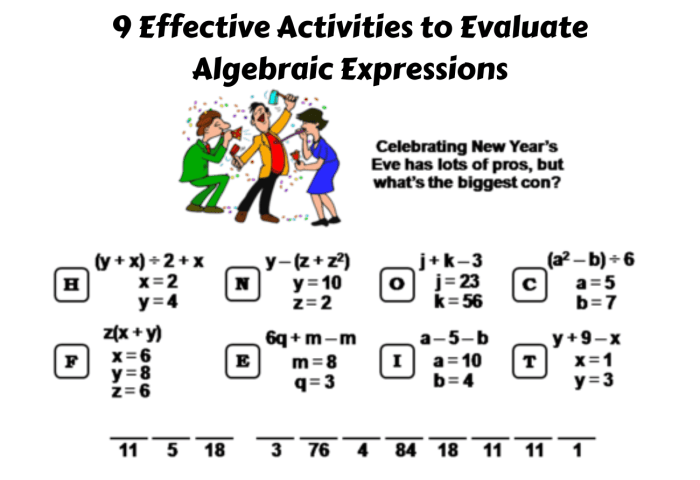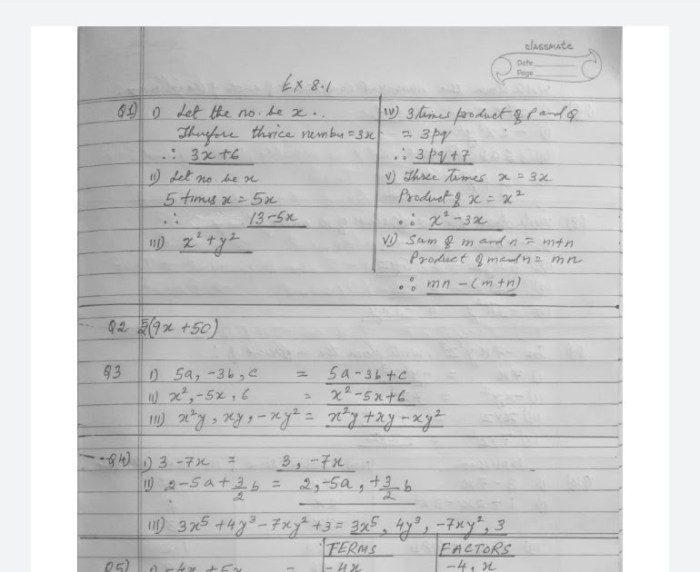Embarking on a journey through algebraic expressions quiz part 2, we delve into the intricacies of simplifying, evaluating, and applying these expressions. This comprehensive exploration unravels the fundamental concepts of variables, constants, and operations, providing a solid foundation for understanding their role in mathematical problem-solving.
As we progress, we uncover the significance of simplifying algebraic expressions, employing techniques like combining like terms and leveraging the properties of operations. Step-by-step examples illuminate the process, emphasizing the importance of simplification in solving equations and performing mathematical operations.
Algebraic Expressions: Basics

Algebraic expressions are mathematical expressions that use variables, constants, and operations to represent mathematical relationships. Variables represent unknown or changing values, while constants represent fixed values.
Common operations used in algebraic expressions include addition (+), subtraction (-), multiplication (× or ·), division (÷ or /), and exponentiation (^). Expressions can take various forms, such as:
- 3x + 5
- (2x – 3)(x + 4)
- x^2 – 4x + 3
When evaluating algebraic expressions, it is important to follow the order of operations (PEMDAS): Parentheses, Exponents, Multiplication and Division (from left to right), Addition and Subtraction (from left to right).
Simplifying Algebraic Expressions

Simplifying algebraic expressions involves combining like terms and using properties of operations to make the expression more concise and easier to evaluate.
Like terms are terms that have the same variable and exponent. For example, 3x and 5x are like terms, and can be combined as 8x.
Some properties of operations that can be used for simplifying expressions include:
- Commutative property: Changing the order of operands does not change the result (e.g., a + b = b + a)
- Associative property: Grouping operands in different ways does not change the result (e.g., (a + b) + c = a + (b + c))
- Distributive property: Multiplying a sum by a term is the same as multiplying each term in the sum by the term (e.g., a(b + c) = ab + ac)
Simplifying expressions is important for solving equations and other mathematical operations, as it makes it easier to identify patterns and relationships.
Evaluating Algebraic Expressions
Evaluating algebraic expressions involves substituting numerical values for variables and performing the indicated operations.
For example, to evaluate the expression 2x + 5 for x = 3, we substitute 3 for x and get:
x + 5 = 2(3) + 5 = 6 + 5 = 11
Evaluating expressions is useful for finding the value of an expression for a given set of variables, which can be applied in various contexts.
Solving Algebraic Equations
Solving algebraic equations involves finding the values of variables that make the equation true.
There are several methods for solving equations, including:
- Isolating the variable:Moving all terms with the variable to one side of the equation and all other terms to the other side.
- Using inverse operations:Performing the opposite operation on both sides of the equation to isolate the variable.
- Factoring:Decomposing an expression into smaller factors to simplify solving.
Solving equations is essential for finding unknown values in mathematical problems and applications.
Applications of Algebraic Expressions: Algebraic Expressions Quiz Part 2

Algebraic expressions have numerous real-world applications in fields such as science, engineering, and economics.
- Science:Modeling physical phenomena, such as motion, gravity, and energy.
- Engineering:Designing structures, circuits, and systems.
- Economics:Representing economic relationships, such as supply and demand, and financial models.
Understanding algebraic expressions is crucial for problem-solving and decision-making in these and other fields.
General Inquiries
What is the primary purpose of simplifying algebraic expressions?
Simplifying algebraic expressions enhances their readability, facilitates problem-solving, and lays the groundwork for solving equations.
How do we evaluate algebraic expressions?
Evaluation involves substituting numerical values for variables and performing the indicated operations to obtain a numerical result.
What are some real-world applications of algebraic expressions?
Algebraic expressions find applications in physics (describing motion), chemistry (calculating concentrations), and economics (modeling supply and demand).